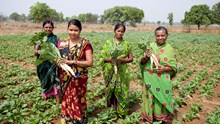
Ginseng refers to several species of perennial plants belonging to the genus Panax, derived from the Greek words “pan” (all) and “akos” (cure), quite literally, “a cure-all.” The most commonly known types are Panax ginseng (Asian ginseng) and Panax quinquefolius (American ginseng). Another plant often referred to as ginseng is Siberian ginseng (Eleutherococcus senticosus), though it belongs to a different genus and lacks some of the same active compounds.
The root of the ginseng plant is what’s used in traditional medicine. Shaped somewhat like a human body, with limb-like offshoots, ginseng roots have long been associated with holistic healing and overall balance.
Traditional and Modern Uses
The use of ginseng can be traced back more than 2,000 years. In traditional Chinese medicine (TCM), ginseng is considered a yang tonic, used to boost energy (qi), strengthen immunity, and restore vitality. Korean traditional medicine also embraces ginseng for similar purposes, particularly during recovery from illness or fatigue.
Today, modern research has caught up with some of these traditional beliefs. Ginseng is classified as an adaptogen, meaning it helps the body resist stressors of various kinds, be it physical, chemical, or biological. Its active components, called ginsenosides, are believed to influence the nervous system, improve metabolism, and support cognitive function.
Some of the commonly recognized benefits of ginseng include:
-
Enhanced cognitive performance: Ginseng may improve memory, attention, and mental clarity.
-
Increased energy and stamina: It is often taken as a supplement to fight fatigue.
-
Improved immune response: Studies suggest that ginseng helps boost the immune system.
-
Anti-inflammatory and antioxidant effects: These properties may support long-term health and aging.
-
Blood sugar regulation: American ginseng, in particular, has shown potential in lowering blood glucose levels.
Ginseng is available in many forms—powdered, capsule, tea, extract, and even as an ingredient in skincare products. But while it’s widely used, it’s also powerful. Health professionals advise moderation and careful consideration, especially for those with underlying medical conditions or those taking medication.
A Slow and Patient Crop: Ginseng Cultivation
Cultivating ginseng is not for the impatient. Unlike many herbs, ginseng takes years to mature, usually between 4 to 6 years before it can be harvested for medicinal use. The older the root, the more potent and valuable it becomes.
Here’s a look at how ginseng is cultivated:
Site Selection
Ginseng thrives under 70% shade and grows best in broad-leaved deciduous forests with trees like oak, walnut, maple, and poplar. Ideal growing conditions are found in rain-shadow temperate regions of the inner Himalayas, particularly in Chamba, Kullu, Kinnaur, and Lahaul districts of Himachal Pradesh. Areas with shallow-rooted understory plants or conifers should be avoided.
Soil Requirements
Loamy, well-drained soil with a slightly acidic pH (5.0 to 6.5) is optimal for Ginseng cultivation. High organic matter or humus content is essential for healthy root development. Fields should have a gentle slope to prevent waterlogging, as ginseng roots are sensitive to excess moisture.
Bed Preparation
Before planting, the field is ploughed 3–4 times. Raised beds, 10–12.5 cm high and 120 cm wide, are created along the contour of the land. This layout helps control erosion and supports moisture management. Farmyard manure (FYM) is avoided due to risks of weed seeds and pests; instead, decomposed leaf litter is recommended.
Sowing and Nursery Development
Seeds are sown at a depth of 12–25 mm, depending on site conditions, and are covered with mulch to prevent drying. High-density sowing (2.5 cm seed spacing) is used for nursery beds, while low-density sowing (15–30 cm apart) is preferred under natural forest shade. The seed rate ranges from 35–100 kg/ha, based on the chosen planting density.
Transplantation
After one year, young rootlets from nursery beds are transplanted into prepared main fields. Transplantation is done before apical growth begins, using a spacing of 10–15 cm between plants and 15–20 cm between rows, to ensure healthy and disease-free growth.
Propagation by Seed
Ginseng is best propagated through seeds, which are recalcitrant and immature at harvest. These seeds require moist stratification, a chilling period lasting up to 18 months to break dormancy and ensure germination. Seed sowing is typically done in autumn, either directly in the field or in nursery beds for later transplantation.
Mulching
Regular mulching is critical for moisture conservation and temperature regulation. Deciduous tree leaves, wheat straw, or oat straw are preferred mulching materials. Mulch must be free from weed seeds or grasses to avoid contamination.
Shade Management
To mimic forest conditions, ginseng fields require 70% shade, achieved through shade net structures about 2.4–3.0 meters high. These structures allow airflow while blocking direct sunlight. Traditionally, thatched covers are used in countries like Korea and China, but modern nets are common in commercial cultivation.
Fertilizer Application
Ginseng does not need chemical fertilizers. Decomposed leaf litter provides sufficient nutrients. A small amount of nitrogen may improve foliage growth, but it has minimal impact on root biomass. The focus is on maintaining a humus-rich, naturally fertile soil.
Irrigation Practices
While ginseng requires consistent soil moisture, it cannot tolerate waterlogged conditions. The ideal moisture level is 40–50% of the soil’s field capacity. Proper shading and mulching help retain moisture, with occasional irrigation as needed. Sprinkler systems are avoided to reduce the risk of fungal disease spread.
Harvesting Time and Method
Ginseng roots are typically ready for harvest after five years in artificially shaded commercial fields. In contrast, plants grown under natural forest shade may take longer due to slower growth and less control over soil conditions. Harvesting is ideally timed after the berries have ripened and the aerial parts begin to senesce.
Before digging, the mulch, plant tops, and shade net structures are removed to allow the soil to dry slightly. Roots are carefully lifted from the beds a few days later to minimize breakage and damage.
Cleaning and Drying
Harvested roots are gently washed with clean water, avoiding any scrubbing that could damage the delicate skin. Drying is a crucial step for preserving quality. Roots are spread in a single layer on wire mesh and dried using warm air at around 35°C, either in a drying cabinet or a well-ventilated room equipped with a fan and room heater.
The drying process should be slow and gradual over 3–4 weeks, reducing the root moisture to about 10%. Properly dried roots snap cleanly when broken, signaling readiness for storage or sale.
Storage
Once fully dried, ginseng roots are stored in cardboard boxes in a cool, dry place. Airtight containers or plastic bags are avoided, as they trap moisture and promote mold growth. With proper care, the dried roots retain their quality until ready for use or marketing.
Yield
Depending on cultivation practices and site conditions, average root yield ranges between 2,500 to 4,000 kg per hectare in established ginseng-growing regions.
Ginseng is more than just a root, it's a living legacy of ancient healing, modern science, and agricultural craftsmanship. From the damp forest floors of North America to the shaded plantations of Korea and China, this humble plant embodies resilience, patience, and natural wisdom.
As interest in herbal wellness continues to grow, ginseng stands tall, offering its storied strength in every root, cup, and capsule. But whether you’re sipping ginseng tea to energize your mornings or considering cultivating it yourself, remember: the real magic of ginseng lies in its time-honored connection between people and nature.
















